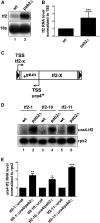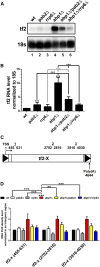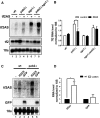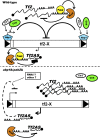Multiple Transcriptional and Post-transcriptional Pathways Collaborate to Control Sense and Antisense RNAs of Tf2 Retroelements in Fission Yeast
- PMID: 28007890
- PMCID: PMC5289841
- DOI: 10.1534/genetics.116.193870
Multiple Transcriptional and Post-transcriptional Pathways Collaborate to Control Sense and Antisense RNAs of Tf2 Retroelements in Fission Yeast
Abstract
Retrotransposons are mobile genetic elements that colonize eukaryotic genomes by replicating through an RNA intermediate. As retrotransposons can move within the host genome, defense mechanisms have evolved to repress their potential mutagenic activities. In the fission yeast Schizosaccharomyces pombe, the mRNA of Tf2 long terminal repeat retrotransposons is targeted for degradation by the 3'-5' exonucleolytic activity of the exosome-associated protein Rrp6. Here, we show that the nuclear poly(A)-binding protein Pab2 functions with Rrp6 to negatively control Tf2 mRNA accumulation. Furthermore, we found that Pab2/Rrp6-dependent RNA elimination functions redundantly to the transcriptional silencing mediated by the CENP-B homolog, Abp1, in the suppression of antisense Tf2 RNA accumulation. Interestingly, the absence of Pab2 attenuated the derepression of Tf2 transcription and the increased frequency of Tf2 mobilization caused by the deletion of abp1 Our data also reveal that the expression of antisense Tf2 transcripts is developmentally regulated and correlates with decreased levels of Tf2 mRNA. Our findings suggest that transcriptional and post-transcriptional pathways cooperate to control sense and antisense RNAs expressed from Tf2 retroelements.
Keywords: Abp1; Pab2; S. pombe; Tf2; retrotransposon.
Copyright © 2017 by the Genetics Society of America.
Figures







Similar articles
-
CENP-B cooperates with Set1 in bidirectional transcriptional silencing and genome organization of retrotransposons.Mol Cell Biol. 2012 Oct;32(20):4215-25. doi: 10.1128/MCB.00395-12. Epub 2012 Aug 20. Mol Cell Biol. 2012. PMID: 22907751 Free PMC article.
-
The fission yeast CENP-B protein Abp1 prevents pervasive transcription of repetitive DNA elements.Biochim Biophys Acta. 2016 Oct;1859(10):1314-21. doi: 10.1016/j.bbagrm.2016.06.009. Epub 2016 Jun 23. Biochim Biophys Acta. 2016. PMID: 27345571 Free PMC article.
-
Restriction of Retrotransposon Mobilization in Schizosaccharomyces pombe by Transcriptional Silencing and Higher-Order Chromatin Organization.Genetics. 2016 Aug;203(4):1669-78. doi: 10.1534/genetics.116.189118. Epub 2016 Jun 24. Genetics. 2016. PMID: 27343236 Free PMC article.
-
The Long Terminal Repeat Retrotransposons Tf1 and Tf2 of Schizosaccharomyces pombe.Microbiol Spectr. 2015 Aug;3(4):10.1128/microbiolspec.MDNA3-0040-2014. doi: 10.1128/microbiolspec.MDNA3-0040-2014. Microbiol Spectr. 2015. PMID: 26350316 Free PMC article. Review.
-
Influence of long terminal repeat retrotransposons in the genomes of fission yeasts.Biochem Soc Trans. 2013 Dec;41(6):1629-33. doi: 10.1042/BST20130207. Biochem Soc Trans. 2013. PMID: 24256266 Review.
Cited by
-
Antagonistic roles by the conserved nuclear poly(A)-binding proteins PABPN1 and ZC3H14 in nuclear RNA surveillance.Nucleic Acids Res. 2025 Jan 24;53(3):gkaf060. doi: 10.1093/nar/gkaf060. Nucleic Acids Res. 2025. PMID: 39898550 Free PMC article.
-
Diverse transposable element landscapes in pathogenic and nonpathogenic yeast models: the value of a comparative perspective.Mob DNA. 2020 Apr 21;11:16. doi: 10.1186/s13100-020-00215-x. eCollection 2020. Mob DNA. 2020. PMID: 32336995 Free PMC article. Review.
-
Transcriptome sequencing and screening of genes related to glucose availability in Schizosaccharomyces pombe by RNA-seq analysis.Genet Mol Biol. 2021 Aug 27;44(3):e20200245. doi: 10.1590/1678-4685-GMB-2020-0245. eCollection 2021. Genet Mol Biol. 2021. PMID: 34460892 Free PMC article.
References
-
- Bähler J., Schuchert P., Grimm C., Kohli J., 1991. Synchronized meiosis and recombination in fission yeast: observations with pat1–114 diploid cells. Curr. Genet. 19: 445–451. - PubMed
-
- Bähler J., Wu J. Q., Longtine M. S., Shah N. G., McKenzie A., 3rd, et al. , 1998. Heterologous modules for efficient and versatile PCR-based gene targeting in Schizosaccharomyces pombe. Yeast 14: 943–951. - PubMed
MeSH terms
Substances
Grants and funding
LinkOut - more resources
Full Text Sources
Other Literature Sources
Molecular Biology Databases
Research Materials
Miscellaneous

